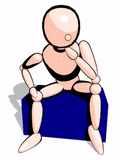
As Osmond Group celebrates 60 years in business on 02.10.2022, we take a look back at the changing world of ergonomics – a space we’ve inhabited for the past 3 decades.
When we think back to the beginnings of the business, the amount of change over that time is astonishing – not just for our company, but for the wider ergonomics sector and the world of work it serves.
From the beginning
Whilst Osmond Group has been around for 60 years, Osmond Ergonomics was founded 30 years ago, born of a serendipitous encounter between our Managing Director Guy Osmond, who had a recurring back injury, and Dr James Robertson, the rheumatologist he was referred to.
James had developed a sloping desk design that was being manufactured in the Rehab Department at Salisbury Hospital. Guy worked with his own carpentry team to create a licenced version of the desktop desk, which became our first ergonomics product – the TOGL Organiser.
This was at a time when the understanding of ergonomics and applications in the workplace were still in their relative infancy, so when this pioneering product was launched at a Health and Safety Expo, it immediately found interest.
Spotting a niche, Guy didn’t leave it there; soon he had three more products – the Screenstep monitor raiser, Footstep footrest, and its taller cousin, the Highstep, all of which he presented at the Royal Society for the Prevention of Accidents Expo soon after.
Being amongst the first to bring ergonomics products to market, Osmond Ergonomics began supplying big companies like Boots and London Electricity very early on, working alongside pioneers like Dr Lynn McAtamney, who developed the Rapid Upper Limb Assessment. The RULA tool for assessing the risk of upper limb disorders represented a great leap forward in the ergonomics field at the time and is still in use today – we offer a free online version if you want to try it.
A shifting landscape
Workplace assessments have been key in the ergonomics sector, underpinned by The Health and Safety (Display Screen Equipment) (DSE) Regulations, 1992 (amended in 2002) which set out guidance for the minimum standards and requirements for working with Display Screen Equipment.
Very early on, we determined that supplying equipment wasn’t enough without the proper assessment, information and support to ensure it would be used correctly and make a positive difference. So, assessment services, alongside information and guidance, became a core part of our offer.
In 1997 this knowledge sharing began with Posture Guidance, including Stretching Exercises for our customers, and from the late 90s we ramped up our talks and education in more settings. Osmond Ergonomics was also a very early adopter of social media; we’ve been posting online since 2009, when we also started our monthly eBulletin, to share the latest information and insights.
Over the years, Osmond Ergonomics has been quick to promote innovative products like laptop stands, mini keyboards and the Rollermouse concept – being one of the first providers to sell these products in the UK. And of course, we’ve continued to expand our range as better designs with more features or greater adjustability came to market.
We have also championed the sit-stand desk – something that has been around for nearly 20 years – long before the somewhat misdirected Get Britain Standing Campaign launched in 2014.
Where do we go from here?
Adapting workstations and equipment to fit the user remains at the core of ergonomics and our business – but over time there has been wider understanding and recognition of the intertwined relationship between mental and emotional health as well as physical needs.
While the word ‘wellbeing’ has only recently entered common parlance, it has always been central to our conversations with every employer and individual. Improving the wellbeing of workers has always been what it’s all about for us, long before we started calling it that.

This still holds true today, as our range has expanded into products such as green walls (to tap into the benefits of biophilic design) and booths, pods and phone boxes to provide the varied settings workers need to support each of the four core working behaviours – Communication, Collaboration, Concentration and Contemplation – the 4Cs.
Having supported homeworkers for more than a decade, becoming specialists, we are once again well prepared when it comes to the latest big shift in the world of work – the move to hybrid and homeworking for knowledge workers.
It’s an exciting time to be working in this fast-moving sector, and we look forward to the future as we continue to help people become healthier, happier and more productive in the workplace.
